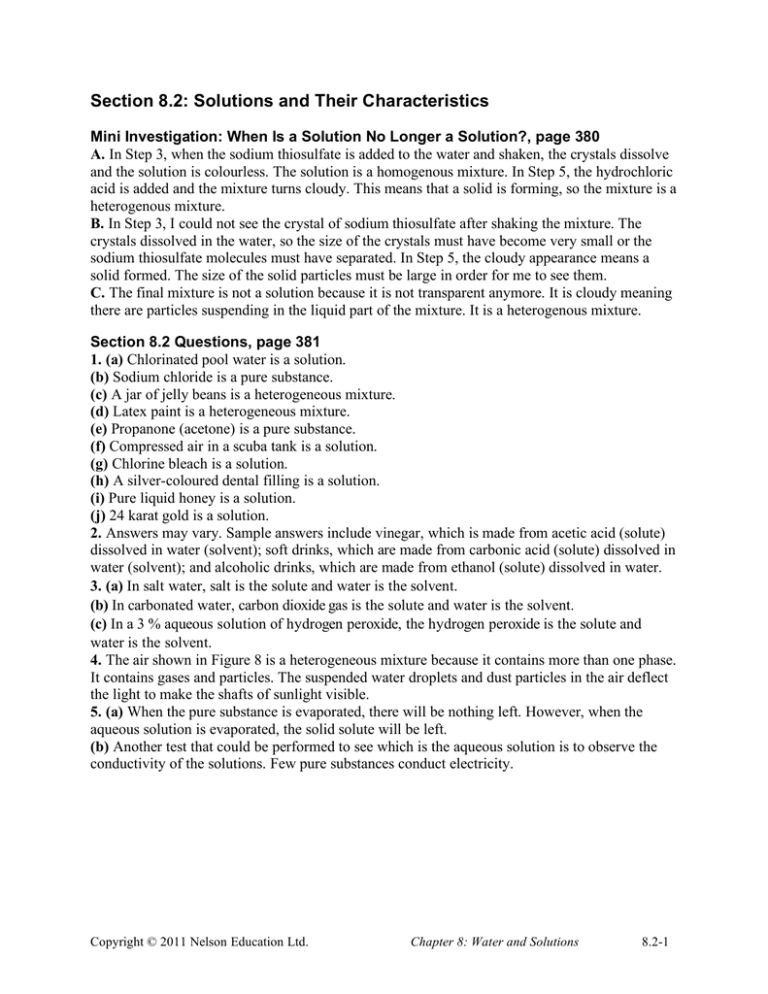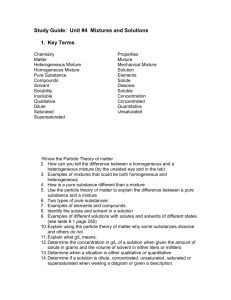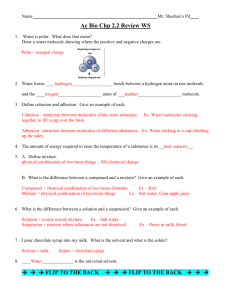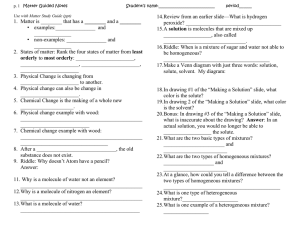Solutions & Mixtures: Textbook Solutions - Chemistry
advertisement

Section 8.2: Solutions and Their Characteristics Mini Investigation: When Is a Solution No Longer a Solution?, page 380 A. In Step 3, when the sodium thiosulfate is added to the water and shaken, the crystals dissolve and the solution is colourless. The solution is a homogenous mixture. In Step 5, the hydrochloric acid is added and the mixture turns cloudy. This means that a solid is forming, so the mixture is a heterogenous mixture. B. In Step 3, I could not see the crystal of sodium thiosulfate after shaking the mixture. The crystals dissolved in the water, so the size of the crystals must have become very small or the sodium thiosulfate molecules must have separated. In Step 5, the cloudy appearance means a solid formed. The size of the solid particles must be large in order for me to see them. C. The final mixture is not a solution because it is not transparent anymore. It is cloudy meaning there are particles suspending in the liquid part of the mixture. It is a heterogenous mixture. Section 8.2 Questions, page 381 1. (a) Chlorinated pool water is a solution. (b) Sodium chloride is a pure substance. (c) A jar of jelly beans is a heterogeneous mixture. (d) Latex paint is a heterogeneous mixture. (e) Propanone (acetone) is a pure substance. (f) Compressed air in a scuba tank is a solution. (g) Chlorine bleach is a solution. (h) A silver-coloured dental filling is a solution. (i) Pure liquid honey is a solution. (j) 24 karat gold is a solution. 2. Answers may vary. Sample answers include vinegar, which is made from acetic acid (solute) dissolved in water (solvent); soft drinks, which are made from carbonic acid (solute) dissolved in water (solvent); and alcoholic drinks, which are made from ethanol (solute) dissolved in water. 3. (a) In salt water, salt is the solute and water is the solvent. (b) In carbonated water, carbon dioxide gas is the solute and water is the solvent. (c) In a 3 % aqueous solution of hydrogen peroxide, the hydrogen peroxide is the solute and water is the solvent. 4. The air shown in Figure 8 is a heterogeneous mixture because it contains more than one phase. It contains gases and particles. The suspended water droplets and dust particles in the air deflect the light to make the shafts of sunlight visible. 5. (a) When the pure substance is evaporated, there will be nothing left. However, when the aqueous solution is evaporated, the solid solute will be left. (b) Another test that could be performed to see which is the aqueous solution is to observe the conductivity of the solutions. Few pure substances conduct electricity. Copyright © 2011 Nelson Education Ltd. Chapter 8: Water and Solutions 8.2-1 6. Heterogeneous liquid mixtures are translucent or opaque because they contain entities that deflect light. Liquid solutions are transparent because they contain entities that are too small to interfere with the passage of light. 7. An amalgam is an alloy, or solution, of mercury with other metals. An alloy is a solution of two or more metals. 8. There is a difference between the size of a water molecule and the size of an ethanol molecule. An ethanol molecule is smaller than a water molecule. When the two liquids are mixed together, the ethanol molecules fall between the water molecules, much like sand will fall between rocks. Therefore, when 50 mL of water is combined with 50 mL of ethanol, there is less than 100 mL of solution because the ethanol molecules move to fill the spaces between the water molecules. 9. (a) Adding more solute will make a concentrated solution that has a relatively high quantity of solute compared to the volume of solution. (b) Adding more solvent will make a dilute solution that has a relatively low quantity of solute compared to the volume of solution. (c) Heating the solution to evaporate some of the solvent will reduce the amount of solvent, producing a concentrated solution. (d) Dividing the solution between two containers will not have any effect on the concentration of the solution. 10. According to the Canadian Dental Association, dental amalgams are not hazardous to a person’s health. They have been used for 150 years and there is scientific evidence to indicate that significant risks are not involved with their use. Dental amalgams are strong, durable, and have a reasonable cost. There is research into finding durable alternatives to dental amalgam. Composite resins, gold, and ceramics can be used to fill teeth, but there are advantages and disadvantages to each material. Health Canada suggests that people consider using a product that does not contain mercury when amalgam fillings need to be repaired although it does not suggest replacing all fillings. Health Canada also advises dentists to use non-mercury filling materials in children’s teeth. People should talk about their concerns with their dentist to make sure that they are comfortable with the treatment proposed. Copyright © 2011 Nelson Education Ltd. Chapter 8: Water and Solutions 8.2-2 11. Oxygenates are compounds that are added to gasoline to improve combustion efficiency and reduce pollutants. Ethanol is produced from corn and wheat in Canada. About 7 % to 10 % of ethanol is blended with gasoline in North America. The benefits of using ethanol include reducing Canada’s dependence on imported oil, creating jobs related to the production of ethanol, and reducing greenhouse gas emissions. Another oxygenate used in gasoline is methyl tertiary butyl ether (MTBE). However, it is a source of concern as it has been found in groundwater. Copyright © 2011 Nelson Education Ltd. Chapter 8: Water and Solutions 8.2-3





